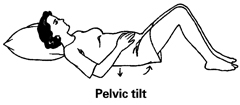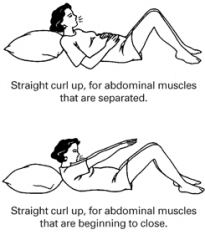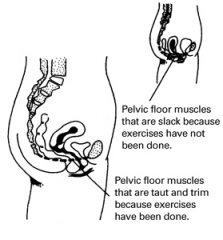Topic 1: Postnatal
Your body
After giving birth, your body will slowly begin to return to normal. Do not worry if your tummy still bulges. Part of the reason is that your uterus is still distended—but breastfeeding will speed up the contractions that make it normal again. (You may feel these contractions as pains in the abdomen, especially when the baby is sucking.)
Your abdominal muscles also need time to regain their strength after months of being stretched. Most women should be able to start gentle exercises 24 hours after the birth. Check with the hospital or your healthcare professional.
Do not panic if your breasts become huge, lumpy and painful in the first few days. This occurs because they are engorged with milk. It is only temporary and the hospital staff or healthcare professional will show you how to deal with this.
Postnatal exercises
Postnatal exercises will strengthen muscles stretched in pregnancy and labour.
The Pelvic tilt
Put your hands onto your abdomen to feel your muscles tighten. Breathe normally as you pull in your abdominal muscles, then flatten the hollow of your back onto the floor and squeeze your buttocks together. Try to hold this position for six seconds, then slowly relax. Feel the pelvis tilt backwards as you flatten your back. Do not hold your breath.
This exercise helps you to maintain good posture. Practise it as often as you can in different positions, e.g. lying on your side, kneeling on all fours, sitting in a chair or standing.
Raise and lower knees
Lie on your back as for pelvic tilt. Flatten the small of your back onto the floor. Lift one knee towards your chest, keeping it bent, followed by the other knee. Hold it for six seconds, keeping your back flat.
Now, slowly lower one leg at a time back to the floor, still keeping your back flattened. Relax. Do not hold your breath.
Straight curl up
Fold arms across your abdomen to support the separated muscles, as usually, to a certain extent, they have separated. Raise head and shoulders as you breathe out until the separation begins to “bulge”. Hold for six seconds, breathing normally, then lower back slowly. Relax. Do not curl up further than halfway to the knees.
For abdominal muscles that are separated: If your muscles are very weak, you may need to start this exercise with your head and shoulders raised on several pillows. Practise straight curl ups frequently everyday day in the first days after the birth. This will quickly close the separation between the abdominal muscles. Then move on to straight curl ups for abdominal muscles that are beginning to close.
For abdominal muscles that are beginning to close: When you can do this exercise easily, do the same exercise with your arms folded across your chest. When this feels easy to do, do it with your hands behind your head, keeping your elbows back and level with your ears.
Isometric abdominal exercise
Sit in a chair with your back and feet supported. Press the heel of your right hand against the inside of your left knee. Do not let the knee move. Hold for six seconds, feeling your abdominal muscles tighten. Relax slowly. Repeat with the left hand against the right knee.
When you can do this exercise easily, go on to diagonal curl up.
Diagonal curl up
Lie down, with your legs straight and your arms by your side. Slowly curl up to a sitting position as you breathe out, reaching both hands towards the outside of one knee. Hold for up to six seconds, breathing normally. Lie back down slowly and relax. Repeat to the other side.
When you can do this easily, try the same exercise with your arms folded across your chest, bringing your elbow towards your knee.
Exercise for pelvic floor muscles
- Some loss of control over urine and bowel action. The odd “leak” when you sneeze, cough or jump might only seem a nuisance to begin with. However, if you do not get it under control early on, you can have more serious problems with incontinence as you get older;
- Prolapse or “dropping down” of the bladder and uterus;
- Less pleasure during sexual intercourse due to lax vagina. You may have more difficulty reaching orgasm.
The following exercises will help prevent “leaking” of urine when you cough or laugh.
- Lie back with head and shoulders well supported and raised on pillows. Your knees should be bent up and apart, with feet flat on the floor.
- Tighten and “pull up” the muscles around the vagina and anus. Hold, then slowly relax. It feels as if you are trying to stop yourself from urinating or having a bowel movement.
- Be aware of the “released” feeling in these muscles around the vagina as you relax them. It will be important for you to relax like this during the second stage of labour.
- Once you have practised this lying down, practise it sitting and standing as well. Try to do up to 50 contractions every day in groups of five. Hold each, tightening for a few seconds at first, gradually bringing up to six seconds.
When you do lift, make sure you do it the right way:
Bend your knees, not your back, and tighten over your pelvic floor muscles at the same time. Keep your feet apart, one in front of the other. Keep the load close to your body.











